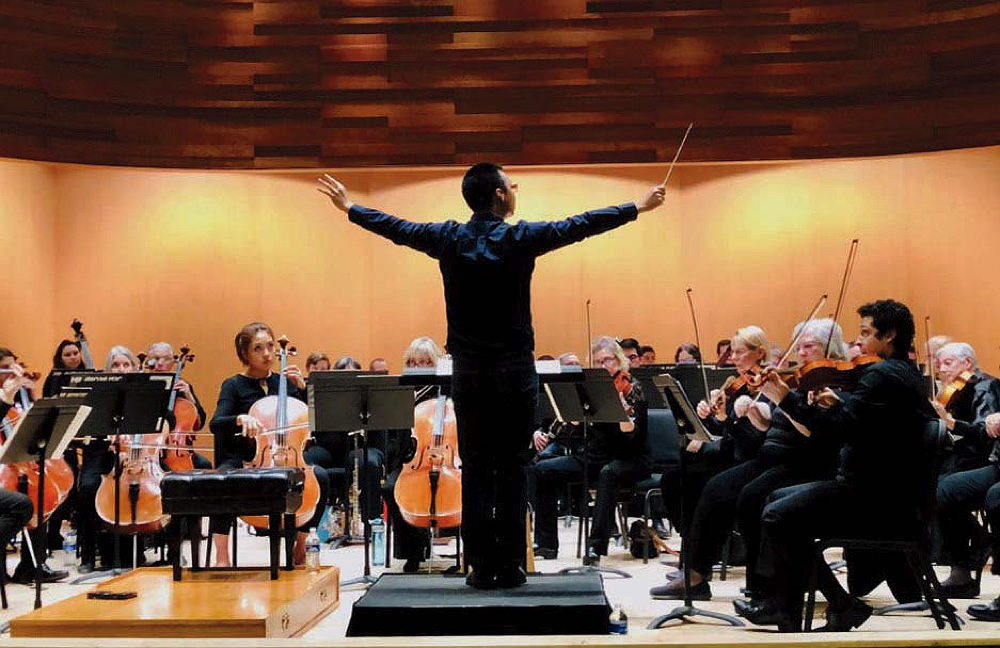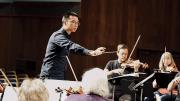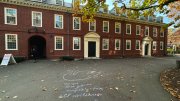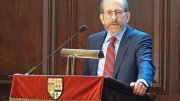On a table in the center of Holden Chapel rest a book, an unlit lamp, a potted leafy plant, and a ramekin of water. Visitors at Harvard’s 2017 ARTS FIRST Festival enter the darkened sanctuary one at a time, alone, and don an electroencephalogram (EEG) headband that detects electrical activity in their brains. For a moment, the chapel is silent—then, a piece by composer Sam Wu ’17 begins. The otherworldly overtones of glass harmonica (an instrument made from rubbing the rims of water-filled wineglasses) float above a simple piano melody. The participant approaches the table and notices that the ramekin and plant are gently vibrating—leaves rustling, water blooming with ripples. As he peruses the book of drawings and writings by the show’s head designer, visual artist Wa Liu, the EEG headband detects his increased focus and sends a signal to the objects on the table. The lamp lights as his concentration intensifies; the vibrating plant and water slow their movements. The participant’s inner focus produces an external moment of stillness. Finally, when he finishes the book and his attention wanes, the lamp dims, the objects begin to shake, and the chapel turns dark and silent once again.
This piece, titled Still, is just one in a long line of Wu’s compositions that he says “deal with the beauty in blurred boundaries”—those between familiar and unusual instrumentation, technological and classical craftsmanship, and aural and visual artistry. But long before Still, before he won one of the highest honors for a burgeoning composer (the ASCAP Foundation Morton Gould Young Composer Award), before his music had been performed on five continents, Sam Wu wanted to be an architect.
Born in Australia, raised in Shanghai, and educated at an international school, Wu was fascinated by Shanghai’s architectural smorgasbord growing up. He explored the “glitzy, futuristic-looking skyscrapers” of downtown, the early-twentieth-century European-style houses of the French Concession, and the traditional imperial architecture of the city outskirts. A self-proclaimed “public transit nerd,” he created mental maps of the routes he took around the city and spent summer days constructing buildings on the 3D design software, SketchUp. Those digital skyscrapers marked one of his first encounters with “that warm, fuzzy sense of achievement I got from having created something.”

Sam Wu conducts his composition, The Building of a City, with the MusicaNova Orchestra in Phoenix, Arizona, in January 2020.
Photograph courtesy of Sam Wu
That feeling stuck. He realized he could make art that was musical, not just visual, when he saw his middle-school orchestra teacher fiddling around on the notation software, Sibelius. “He told me it was like Microsoft Word for music. To me, it was like a video game,” Wu says. Composing came naturally to Wu, a student violinist, as he found similarities between designing buildings and creating music: “The same laws of physics govern both: gravity, and the nature of resonance, vibration, and the harmonic series.” An accidental discovery, composing became the centerpiece of his life.
By the time he finished high school and started a joint concentration in East Asian studies and music at Harvard, Wu had toured Australia, New Zealand, and Japan as the intern to Chinese composer Tan Dun, and he had already had his own compositions performed by orchestras internationally. After graduating, he jumped straight into a master’s program at the Juilliard School and is now pursuing a Doctor of Musical Arts at Rice University’s Shepherd School of Music.
A long way from noodling around on Sibelius, these days Wu grounds his composition process in concepts ranging from climate science (one of his favorite websites is “Tropical Tidbits,” where a scientist posts daily meteorology videos) to science fiction (he loves The Expanse, a television drama about exoplanets). His piece [alien forests] is based on a daydream he had about the strange flora that might exist on a not-yet-discovered exoplanet. He explains, “I think I would have trouble writing something that’s just called a sonata.”
He’s especially inspired by visuals, like Mass Transit, where each movement represents a different facet of the Shanghai metro system. Listeners “ride” the subway during the elegant string orchestration of “network architecture,” wander Shanghai’s city gardens in the organic-sounding, serene “garden city,” catapult toward international travel over the rolling piano line of “airport express,” savor the charged stillness of the city after dark with “night skyline,” and finally navigate the chaos of a subway station to the piano quintet’s sharp counterpoint in “interchange station.” Between each movement, the piano plays a note series reminiscent of the subway “doors-closing” chime.
Most of his music is written for orchestras and Western instruments, but Wu also works with players of Eastern instruments, such as the morin khuur (Mongolian horsehead fiddle) and shakuhachi (Japanese flute). “I want to write for whatever I’m hearing in my mind,” he adds. “That could be a Chinese folk song, or it could be Beethoven. All of that is equal inspiration, equal influence.”
Perhaps a testament to its “blurred boundaries,” Wu’s music is hard to describe, but it’s impressionistic, textured, colorful, richly orchestrated, and kinetic even in its slow movements. One could maybe say it sounds like what would happen if Copland and Ravel lived in a high-rise on an alien exoplanet 200 years from now.
Despite the loftiness of Wu’s concepts, his composition process is highly physical: pen and paper, fingers on a piano so he can “feel the weight of the music in the air,” and asking himself one question over and over: Does this feel right? “I’m not even asking myself if it sounds right. It’s about, does this viscerally feel like it needs to be there?”
Three years ago, Wu had to reimagine his creative process when he could no longerfeel the music. Sudden sensorineural hearing loss in his left ear severely distorted his perception of pitch and timbre. He has since recovered, but for a long stretch, “Every piano sounded out of tune.” Around that time, he was composing Wind Map, a piece inspired by a graphic of global wind patterns, selected to be performed by the Sarasota Orchestra. He finished the composition without truly hearing, or more importantly, feeling it.
“The scariest part of what I do is that first downbeat in the rehearsal room,” he says, but few downbeats were scarier than the one in Sarasota. “We’re never in control as composers,” he adds, and it was especially out of his hands that day. But the first downbeat came without a hitch, and then the next, and soon, the orchestra was bringing Wu’s music to life. Now he sees beauty in the give-and-take of composing—or as he describes it, the “counterpoint” among the composer, performer, and audience. “Composers give a blueprint, but the actual building is a collaboration between a village,” he says. And just as it was for teenage Wu designing skyscrapers on SketchUp, and college-aged Wu helping to bring Still to lifein Holden Chapel, he once again felt that fuzzy feeling of having created something, this time with a village behind him.








